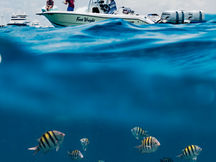
Diving in the Seychelles
The large islands of the archipelago and the seabed surrounding them are composed mostly of granite rocks, while the small ones are usually coral. From here - the unique underwater landscapes of the Seychelles archipelago. Visibility under water usually exceeds 30 meters, and the water temperature is kept at around +26..+38 °C.
There are more than 900 species of fish, 100 genera of shells and 50 varieties of corals. Not surprisingly, the Seychelles hosts SUBIOS, the annual festival of films shot underwater in the Indian Ocean. Minimal currents, an abundance of fish, colorful corals and an above-average chance of seeing large ocean life such as manta rays, turtles and whale sharks all make the Seychelles a top-notch diving area.
The most popular dive sites are perhaps the following:
-
Trompeuse Rocks, which rises to the surface of the water from a depth of 20 m. There are a large number of huge schools of musketeer fish, tuna, pennant fish and sharks.
-
Mamelles is a small uninhabited island 11 km from Mahe with a cove among rocks ending in a through cave.
-
The Ennerdale is a tanker that once belonged to the British Navy, and now belongs to the waters of the Indian Ocean, has its underwater history since the early 70s. At this unfortunate time for him, he ran into a rock that was not marked on the map, now named after him, and sank 3 km from it. But its glorious history did not end there: now this "wreck" attracts divers from all over the world, becoming home to giant eels, scorpions, stingrays, lionfish (lion-fish), pennant fish, barracudas, sharks and giant cod. The treacherous rock itself is interesting for large octopuses and lobsters, which often visit it.


































































